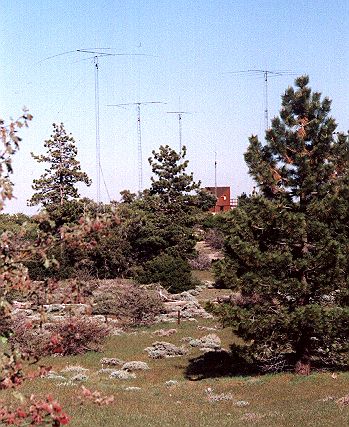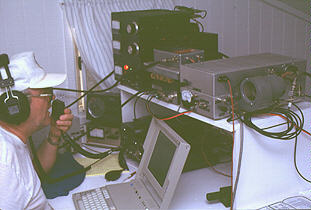About amateur
radio and the N6NB "antenna farm"...
This page was written for two kinds of readers:
those who came here from the communications law website via the photo album,
and those who arrived via an amateur radio link on the Internet.
Let's begin with a short introduction to amateur radio for those who are
not familiar with this avocation.
Amateur radio is a purely non-commercial form of
local or international two-way communications. About two million
people worldwide are licensed amateur or "ham" radio operators. To
obtain an amateur radio license, one must pass a government-approved exam.
Each amateur operator has a call sign; mine is N6NB. Some
amateurs are perfectly content with nothing more than a handheld radio
transceiver for local communications. Others are passionate about
building elaborate radio stations in outstanding locations such as this
mountaintop property in the Tehachapi Mountains 100 miles north of Los
Angeles. A station such as this one can provide reliable worldwide
communications on a daily basis.
My dream of owning a mountaintop radio station began
to become a reality in 1993 when I located and bought a suitable 8-acre
site. That marked the beginning of a long and difficult do-it-yourself
construction project that could never have been completed without the help
of several friends. Hundreds of hours of volunteer labor went into
this project. Here's a PDF show of the construction in 1995--plus the effects of ice storms every winter.
 Because the property is isolated at the end of a rugged, 10-mile dirt road,
there is no infrastructure--no water, no electricity, no sewer lines, no
telephone service. We decided to build a small cabin and three accessory
buildings, including a guest cabin, a storage building and a building to
house a generator to provide electric power. We also put up six radio
towers, only five of which are visible in the photograph at left.
Many tons of building materials had to be hauled up the dirt road in a
van and turned into buildings--by people whose building trades experience
was straight out of Home Improvement. And the designs won't
ever be featured in Architectural Digest. But the buildings
were functional--and they seemed to survive the most violent winter
storms. (Unfortunately, everything shown in these photos was destroyed
by a fire in 2011.)
Because the property is isolated at the end of a rugged, 10-mile dirt road,
there is no infrastructure--no water, no electricity, no sewer lines, no
telephone service. We decided to build a small cabin and three accessory
buildings, including a guest cabin, a storage building and a building to
house a generator to provide electric power. We also put up six radio
towers, only five of which are visible in the photograph at left.
Many tons of building materials had to be hauled up the dirt road in a
van and turned into buildings--by people whose building trades experience
was straight out of Home Improvement. And the designs won't
ever be featured in Architectural Digest. But the buildings
were functional--and they seemed to survive the most violent winter
storms. (Unfortunately, everything shown in these photos was destroyed
by a fire in 2011.)
For those interested in amateur radio, the antennas
in the photo are as follows (from left): a 2-element 40-meter Yagi
on a 70-foot tower, a 4-element triband Yagi on a 50-foot tower, a 4-element
15-meter Yagi on a 50-foot tower and a 4-element 20-meter Yagi on a 70-foot
tower. Partially obscured is a small tower for VHF/UHF antennas that
stood near the main cabin. Although these antennas were not exceptionally
high
above ground level, the height above average terrain
was as much as 5,000 feet in several key directions. The station
was capable of transmitter power output approaching the legal limit (1500
watts p.e.p.) on 3.5 - 222 MHz, with lower power on all amateur bands up
to 10 GHz.
 The primary use of the Tehachapi Mountain station was operating in radio
contests
in
which thousands of amateur operators nationwide or worldwide attempt to
make as many two-way contacts to as many different geographic areas as
possible in a given period of time (e.g., a weekend). Once it became
operational late in 1995, this station acquitted itself well, achieving
#1 scores nationally or regionally in a number of contests. The most
frequent operator of the station was John Desloge, N6MU, shown here at
the VHF/UHF console in the loft of the main cabin. There was another
operating console for HF work downstairs; it is shown below with Scott
Bovitz, N6MI, at the controls. The two consoles could be on the air
simultaneously. For more about our contest results, click
here.
The primary use of the Tehachapi Mountain station was operating in radio
contests
in
which thousands of amateur operators nationwide or worldwide attempt to
make as many two-way contacts to as many different geographic areas as
possible in a given period of time (e.g., a weekend). Once it became
operational late in 1995, this station acquitted itself well, achieving
#1 scores nationally or regionally in a number of contests. The most
frequent operator of the station was John Desloge, N6MU, shown here at
the VHF/UHF console in the loft of the main cabin. There was another
operating console for HF work downstairs; it is shown below with Scott
Bovitz, N6MI, at the controls. The two consoles could be on the air
simultaneously. For more about our contest results, click
here.
 For more information about amateur radio, a good place to start is the
website of the American Radio Relay League,
which has materials not only for people who are already radio amateurs
but also for anyone who might be interested in obtaining a license and
getting on the air. Those already familiar with amateur radio might
want to check out the N6NB page, which includes
articles about many topics related to this pursuit.
For more information about amateur radio, a good place to start is the
website of the American Radio Relay League,
which has materials not only for people who are already radio amateurs
but also for anyone who might be interested in obtaining a license and
getting on the air. Those already familiar with amateur radio might
want to check out the N6NB page, which includes
articles about many topics related to this pursuit.
-Wayne Overbeck, N6NB
|
 Because the property is isolated at the end of a rugged, 10-mile dirt road,
there is no infrastructure--no water, no electricity, no sewer lines, no
telephone service. We decided to build a small cabin and three accessory
buildings, including a guest cabin, a storage building and a building to
house a generator to provide electric power. We also put up six radio
towers, only five of which are visible in the photograph at left.
Many tons of building materials had to be hauled up the dirt road in a
van and turned into buildings--by people whose building trades experience
was straight out of Home Improvement. And the designs won't
ever be featured in Architectural Digest. But the buildings
were functional--and they seemed to survive the most violent winter
storms. (Unfortunately, everything shown in these photos was destroyed
by a fire in 2011.)
Because the property is isolated at the end of a rugged, 10-mile dirt road,
there is no infrastructure--no water, no electricity, no sewer lines, no
telephone service. We decided to build a small cabin and three accessory
buildings, including a guest cabin, a storage building and a building to
house a generator to provide electric power. We also put up six radio
towers, only five of which are visible in the photograph at left.
Many tons of building materials had to be hauled up the dirt road in a
van and turned into buildings--by people whose building trades experience
was straight out of Home Improvement. And the designs won't
ever be featured in Architectural Digest. But the buildings
were functional--and they seemed to survive the most violent winter
storms. (Unfortunately, everything shown in these photos was destroyed
by a fire in 2011.)
 The primary use of the Tehachapi Mountain station was operating in radio
contests
in
which thousands of amateur operators nationwide or worldwide attempt to
make as many two-way contacts to as many different geographic areas as
possible in a given period of time (e.g., a weekend). Once it became
operational late in 1995, this station acquitted itself well, achieving
#1 scores nationally or regionally in a number of contests. The most
frequent operator of the station was John Desloge, N6MU, shown here at
the VHF/UHF console in the loft of the main cabin. There was another
operating console for HF work downstairs; it is shown below with Scott
Bovitz, N6MI, at the controls. The two consoles could be on the air
simultaneously. For more about our contest results,
The primary use of the Tehachapi Mountain station was operating in radio
contests
in
which thousands of amateur operators nationwide or worldwide attempt to
make as many two-way contacts to as many different geographic areas as
possible in a given period of time (e.g., a weekend). Once it became
operational late in 1995, this station acquitted itself well, achieving
#1 scores nationally or regionally in a number of contests. The most
frequent operator of the station was John Desloge, N6MU, shown here at
the VHF/UHF console in the loft of the main cabin. There was another
operating console for HF work downstairs; it is shown below with Scott
Bovitz, N6MI, at the controls. The two consoles could be on the air
simultaneously. For more about our contest results,  For more information about amateur radio, a good place to start is the
website of the
For more information about amateur radio, a good place to start is the
website of the